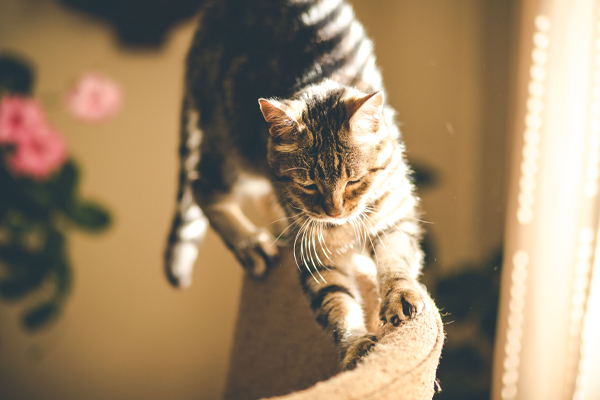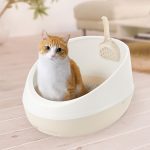
Cats and Claws. That’s a challenging combination that has kept many cat owners awake at night with unsettling thoughts of scratched body parts, shredded curtains, remodeled furniture and tall bed spindles turned scratching posts. There is no doubt that if you are a cat owner or a want to be cat parent, the combination of cat and claws makes for a formidable foe.
There tends to be some confusion among the general public about the roughly 18 somethings cats have sticking out between their four paws. Are they claws or are they nails? If one has ever been scratched by a cat, the answer is very obvious, but if one hasn’t yet experienced that pleasure, the answer is CLAWS. Most mammals have claws. However, humans and primates have nails. Elephants too, but that’s another story. Cat claws are unique in the animal world in that they retract to remain sharp and extend upon command when cats want to claw, climb, or catching things. That way their claws remain razor-sharp. A cat’s claws grow in layers. When scratching, a cat sheds the outermost layer to expose the next sharper layer. This, along with being able to retract their claws, allows their claws to stay sharp all the time. That’s why cats like scratching posts or your furniture – whichever is the most accessible.
With these specialized tools of destruction at their beck and call 24/7, how could any sane cat parent enable their kitty to keep these daggers intact and risk others being harmed? It’s a question many have asked. Luckily, there are many solutions to the myriad of possibilities when it comes to cats being able to live safely with their claws still available to them. These solutions will be covered in the information below so every cat owner can choose the right routine that puts everyone in a safe place.
Bad Sharp
Sharp cat claws are bad news for both cats and cat parents. Not only can sharp claws scratch and possibly draw blood, but they can get caught in carpet or upholstery and cause the cat a lot of pain – especially if the claw gets torn. Sharp claws can also tear up furniture, draperies, wood pieces, and anything else your feline companion decides to turn their attention to. Luckily, simply removing just the tips with regular trimmings is enough to alleviate much of the danger when it comes to sharp claws. Another possible solution is Cat Caps – soft claw caps for cats.
Good Sharp
Just as sharp knives are more effective and less dangerous than dull ones, the same applies to claw trimming devices. Whether you’re more comfortable with specialty scissors, human nail clippers, or sliding guillotine-style clippers, the main emphasis should be on making sure whichever device you use is as sharp as it can be. If it is dull, the added pressure when the claw is pressed down upon may allow the claw to split or bleed. However, no matter if the cutting device is sharp or dull, it’s always good to have some styptic powder, corn starch, or a dry soap bar at the ready to rub on any bleeding claws if the trimming accidentally gets into the quick.
Begin Early
Ideally, starting the claw trimming experience when your cat is still a kitten is the optimal way to approach this subject. This extra time as your cat grows up will allow for plenty of paw touching and holding and will come in handy for when it’s time to start cutting their claws. And when cats are young, their claws aren’t as hard or thick as they will eventually get, so beginning the trimming process when they are little has a lot of advantages. However, even if your cat is an adult, it’s not too late to start working with them to make claw trimming time a pleasant, or as pleasant as possible, experience.
Getting Comfortable
Some cats dislike having their feet touched or played with. It can be worse for them than getting their claws cut. But many cats will enjoy the additional attention. Spending some extra time ahead of trimming day to helping your cat get into a comfortable position sitting in your lap or one arm and having their paws touched and massaged will pay big dividends going forward. You can even practice pressing on the paw pad and making the claw protrude. This is a great time to identify the difference between the quick and the rest of the nail.
If your cat is already grown, you may want to give a treat after every successful series of paw touches, holds, or caresses – especially if your cat is sensitive to someone touching their paws. You can even practice cutting uncooked thick spaghetti pasta with your cutting device while holding your cat to get him used to that kind of sound. Be sure to give him a treat after cutting the pasta to let him know that the sound is ok and worthy of a treat. That way when claw cutting does commence, he will be used to the sound and be looking forward to a treat.
Quick on the Draw
Cats have semi-translucent nails, so finding the quick (pink area of the nail that contains nerve and blood vessels) that lies near the bone end of the paw is fairly easy. It’s a lot simpler to find than it is with some dogs who can have opaque claws. If you are a beginner at cutting cat claws, it is best to just nip off the very ends to make sure you don’t find the quick. If you have some experience cutting cat or dog nails, then you can get a little closer to the quick when making your cuts. Just be sure to be quick in your cutting motion so the cut is clean and the claw isn’t crushed or mashed. Sometimes a slow cut will mash the claw instead of cutting it cleanly.
Get to Know the Clipper
Just as it’s good for you to know all the features of the clipper you will use, it’s also good for your furry friend to get to know the clipper as well before it is put into use. Whether you opt for a human nail trimmer, scissor-style clippers, or a guillotine-style clipper that has a ring in which you insert your cat’s nail and then a sharp blade slides across to lop off the end of the nail, just make sure everything is sharp so you cut the nail instead of crushing it. You can leave the clipper out so your cat can check it out on its own and start feeling comfortable about its presence.
Distraction-Free Ambiance
When the time is right to commence trimming, find a quiet, out-of-the-way place where you can set the mood without any distractions, including any other family pets. This should just be one on one time with your kitty. Spend some time brushing, combing, and petting your cat before reaching for their paws.
Clipping Time
Now that all the practicing is finished and the mood has been set, it’s time to begin the clipping phase. If you have practiced holding your cat while playing with or caressing his paws, simply place your cat in your lap facing away from you and take one of your cat’s paws. While holding his leg, use your thumb and index finger to press on his paw, thus “squeezing” his claw out of his pad. If the claw needs a trim, either snip off the very tip or get in a little closer - all the while making sure to identify and stay far enough away from the quick. Be sure to clip each claw confidently and with a quick movement to make sure you cut instead of crush the claw.
If your cat is still a little gun shy, another clipping method is to lightly place a towel over your cat’s head. This calms down some cats. You can even wrap your cat in a towel, thus exposing only one paw at a time. Groomers call this the “kitty burrito”. Feline pheromones have also been known to help. Above all else, remain calm since your cat can easily read your mood, and the more confident and assured you are the more confident and assured your cat will be. Some soft, relaxing music can help as well.
Once a nail or two have been trimmed, it’s time to either reward with a treat if your cat seemed to notice what was going on or continue to the next nail if nothing is amiss. If your kitty complains too much, just release him and let him go about his way until he is ready again. This will show that claw clipping is a somewhat fun activity and not something that’s forced.
If the quick is accidentally nicked and blood starts to flow, stay chill as if nothing happened. This will help calm your cat as well. Simply apply some styptic powder or cornstarch and hold the claw in a towel for a minute or two until the bleeding stops.
Set a Schedule
Clipping your cat’s claws regularly every few weeks is important for their health and well-being. The frequency will help cut down on the stress each time, and your cat, your family, and your home will be healthier because of the set schedule. Regular claw trimmings also cut down on thoughts of possibly declawing a cat, which is essentially surgical amputation.
It’s fairly popular to only cut the front paws, but the back claws can get long as well. Take a look at all four paws and determine which ones need to be trimmed. Cats can be more sensitive about their back paws, so a good place to start is at the front.
Cats often appear to be self-sufficient and solely capable of taking care of themselves. It’s their more independent nature that lends many to think that they don’t need much if any, human assistance. However, this just isn’t the case. Their health, fur, teeth, and claws all need our assistance if a cat is to be its best. Doing our part as responsible pet owners to help our feline companions by taking them to the vet, brushing and combing their fur, changing their litter box, and trimming their claws regularly is what is required of cat owners so the family feline doesn’t just survive, but thrives.
 Homemade Dog Food & Treats - Pros and Cons
Homemade Dog Food & Treats - Pros and Cons
03.03.2021
Commercial dog food is once again making the news. Unfortunately, the headlines point to a recall of dog food that contains lethal concentrations of aflatoxins, ... >>> READ MORE
 Housetraining 101: How to Potty Train a Puppy
Housetraining 101: How to Potty Train a Puppy
02.01.2021
Congratulations! If you are reading this blog article then you are likely a proud pet parent of a new puppy or you know someone who is. Housetraining, aka potty training, is the cornerstone to a happy and rewarding bond between a dog and its owner. >>> READ MORE
 The Importance of a Clean Litter Box
The Importance of a Clean Litter Box
12.30.2020
Cats are notoriously clean animals. Nature has selected this trait as being supremely beneficial for cats in the wild. Luckily, domestic cats have retained this behavior. >>> READ MORE
 Dog Park 101: Tips for Visiting Your First Off-Leash Dog Park
Dog Park 101: Tips for Visiting Your First Off-Leash Dog Park
12.01.2020
So you’re thinking about visiting an off-leash dog park for the first time. Or perhaps you’ve already been to a dog park and want to see if you got things right... >>> READ MORE
Please complete this form and click "Submit". Our Customer Support team will gladly address your request and respond in a timely manner.
Richell USA, Inc.
Copyright © Richell, Inc.. All rights reserved